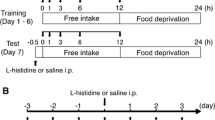Summary
Rats with chronic electrodes in the lateral hypothalamus were induced by electrical stimulation to self-stimulate and drink. The effect of this artificially-elicited drinking on self-stimulation behavior was investigated. Self-stimulation rates at optimal current levels were not changed by induced water intake. However, with the current level just above threshold for self-stimulation the rate was increased significantly when the animals were able to self-stimulate and drink simultaneously. It is suggested that sensory feed-back from the consummatory behavior facilitates the activation of neural circuits in the lateral hypothalamus so that low current stimulation more effectively reinforces self-stimulation.
Similar content being viewed by others
References
Brady, J.V., J.J. Borden, D. Conrad and M. Sidman: The effect of food and water deprivation upon intracranial self-stimulation. J. comp. physiol. Psychol. 50, 134–137 (1957).
Degroot, J.: The rat forebrain in stereotaxic coordinates. Amsterdam: Noord-Hollandsche Uitgevers 1959.
Fisher, A.E., and J.N. Coury: Cholinergic tracing of a central neural circuit underlying the thirst drive. Science 138, 691–693 (1962).
Grossman, S.: Direct adrenergic and cholinergic stimulation of hypothalamic mechanisms. Amer. J. Physiol. 202, 872–882 (1962).
Hoebel, B.G., and P. Teitelbaum: Hypothalamic control of feeding and self-stimulation. Science 135, 375–377 (1962).
Mogenson, G.J., and J.A.F. Stevenson: Drinking and self-stimulation with electrical stimulation of the lateral hypothalamus. Physiol. Behav. 1, 151–154 (1966).
Olds, J.: Effects of hunger and male sex hormone on self-stimulation of the brain. J. comp. physiol. Psychol. 51, 320–324 (1958).
—, and P.M. Milner: Positive reinforcement produced by electrical stimulation of septal area and other regions of rat brain. J. comp. physiol. Psychol. 47, 419–427 (1954).
Rudomin, P., A. Malliani, M. Borlone and A. Zanchetti: A Distribution of electrical responses to somatic stimuli in the diencephalon of the cat, with special reference to the hypothalamus. Arch. ital. Biol. 103, 60–89 (1965).
Sharma, K.: (Personal communication to J.A.F. Stevenson).
Sheffield, F.D., T.B. Roby and B.A. Campbell: Drive reduction versus consummatory behavior as determinants of reinforcement. J. comp. physiol. Psychol. 47, 349–354 (1954).
Tenen, S.S., and N.E. Miller: Strength of electrical stimulation of lateral hypothalamus, food deprivation, and tolerance for quinine in food. J. comp. physiol. Psychol. 58, 55–62 (1964).
Author information
Authors and Affiliations
Rights and permissions
About this article
Cite this article
Mogenson, G.J., Morgan, C.W. Effects of Induced drinking on self-stimulation of the Lateral Hypothalamus. Exp Brain Res 3, 111–116 (1967). https://doi.org/10.1007/BF00233256
Received:
Issue Date:
DOI: https://doi.org/10.1007/BF00233256



